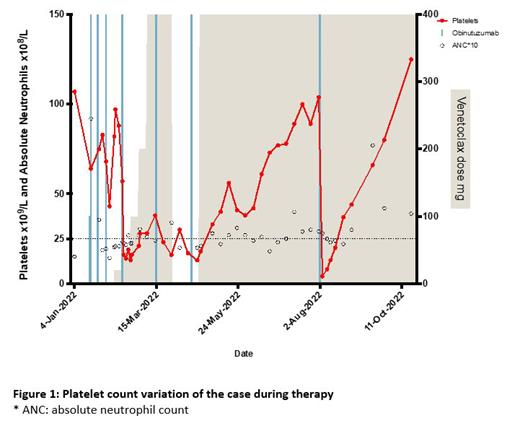Introduction
Obinutuzumab (Obi) is a third-generation anti-CD20 monoclonal antibody widely used in the treatment of B-lymphoproliferative disorders (B-LPD) including follicular lymphoma (FL) and chronic lymphocytic leukemia (CLL). It is infrequently associated with severe thrombocytopenia which can be life-threatening. The pathophysiology is unclear, but platelet clearance can be extremely rapid (<24 hours).
Methods
After obtaining local ethics review, we collected the total number of patients who received Obi as part of multi-agent chemotherapy for the following hematological diseases from 01/01/2015 -01/01/2023: FL (Obi-bendamustine +/- Obi maintenance; Obi-cyclophosphamide/vincristine/prednisone +/-doxorubicin +/- Obi maintenance, Obi-Zanubrutinib (Rosewood trial) and CLL (Obi-venetoclax; Obi-chlorambucil). All cases of clinically suspected Obi-induced thrombocytopenia were reviewed and presented below. All suspected cases were confirmed by evidence of temporal relationship with Obi, spontaneous resolution off Obi, and recapitulation with Obi rechallenge.
Results
Four out of 147 patients receiving Obi-based multi-agent chemotherapy were found to have Obi-induced thrombocytopenia (frequency 2.7%). Two patients were females (50%), and the median age was 78 (range, 72-82) years.
Figure 1 demonstrates the trend of platelet and neutrophils in a patient who received Obi and venetoclax (Ven). Ven was postulated as the cause of the thrombocytopenia, but Ven cessation had no effect on the thrombocytopenia. After suspending Obi, there was a steady increase in the platelet count to 104 x 10 9/L. Obi was re-commenced at cycle 7 (eighth dose) which was followed by a prompt relapse to 4 x 10 9/L 48 hours later. A steady recovery in the platelet count was again seen after ceasing Obi.
The other 3 patients received Obi-bendamustine for FL. For the first patient, thrombocytopenia occurred on day 7 of first cycle (41 x 10 9/L) with a nadir of 14 x 10 9/L on day 11. She received intravenous immunoglobulin (IVIg) and oral corticosteroids due to associated bleeding. The second patient had thrombocytopenia on day 28 of the first cycle (71 x 10 9/L) which decreased to a nadir 13 x 10 9/L while receiving Obi-maintenance. There was no bleeding and Obi was ceased followed by a gradual improvement in thrombocytopenia. For the third patient, thrombocytopenia (41 x 10 9/L) occurred on day 18 of first cycle without bleeding. Obi was changed to rituximab.
Discussion
This is the first known study on the frequency of Obi-induced thrombocytopenia (2.7%). Obi-associated thromboctopenia is severe, sudden-onset, not exclusive to the first cycle of therapy, and the mechanism remains unknown.
The diagnosis may be challenging as patients are often receiving other myelosuppressive therapies. Various strategies may help to elucidate the cause, including correlation with timing of exposure and single agent elimination. Suspension of Obi on suspicion is both an important diagnostic and therapeutic strategy. Obi rechallenge can be considered however thorough patient discussion is required with close monitoring and strategies to manage thrombocytopenia.
In multi-agent chemotherapy studies containing Obi, severe thrombocytopenia of any cause occurred in up to 13% of cases including fatal hemorrhage. The optimal management is unclear. As our cases demonstrate, thrombocytopenia may resolve spontaneously after withdrawing Obi. Analogous to ITP, steroids, and intravenous immunoglobulin (IVIg) have been associated with response whereas platelet transfusions may be ineffective. Two recent cases with severe thrombocytopenia were treated with thrombopoietin receptor agonist (TPO-RA). Other important considerations are regular blood count monitoring and withholding medications which may increase bleeding risk (e.g., anticoagulants) especially during the first cycle.
Summary
Obi is prevalent in the treatment of B-LPD, being used in 6 different regimens in local guidelines. However, clinicians need to be aware of the risk of thrombocytopenia which may be severe. The frequency was 2.7% in this single-center retrospective audit. Correlation with timing of exposure is important. The optimal management is unclear. It may be self-limiting whereas some cases have been treated with steroids, IVIg, and TPO-RA. Further studies are required to delineate the incidence, pathophysiology, diagnosis, and management.
Disclosures
Choi:Janssen: Consultancy, Honoraria; Swedish Orphan Biovitrum: Consultancy; Novartis: Speakers Bureau; Amgen: Speakers Bureau.


